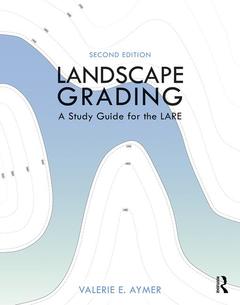Description
Landscape Grading (2nd Ed.)
A Study Guide for the LARE
Author: Aymer Valerie E.
Language: English
Subject for Landscape Grading:
Keywords
Spot Elevation; soil cut; Maximum Allowable Slope; LARE; Vice Versa; landscape architecture student; Cross Slope; horizontal and vertical curves; Longitudinal Slope; landscape grading standards; Drain Inlet; Maximum Slope; Slope Interval; Ramp Run; Building Pad; Closed Drainage System; Invert Elevation; Retention Pond; Rim Elevation; Contour Lines; Minimum Slope; Vertical Change; Grading Problem; Sag Vertical Curve; Wing Walls; Culvert Pipe; Catch Basin; Vertical Curves; Subsurface Drainage Pipes; Sheet Drainage
Publication date: 05-2020
· 21.9x27.6 cm · Hardback
Publication date: 05-2020
· 21.9x27.6 cm · Paperback
Description
/li>Contents
/li>Readership
/li>Biography
/li>
For every element that we design in the landscape, there is a corresponding grading concept, and how these concepts are drawn together is what creates a site grading plan. This study guide explores these concepts in detail to help you learn how to grade with confidence in preparation for the Grading, Drainage and Construction Documentation section of the Landscape Architecture Registration Examination (LARE).
This updated second edition is designed as a textbook for the landscape architecture student, a study guide for the professional studying for the LARE, and a refresher for licensed landscape architects. New to this edition:
? Additional illustrations and explanations for grading plane surfaces and warped planes, swales, berms, retention ponds, and drain inlets;
? Additional illustrations and explanations for grading paths, ramp landings, ramp/stair combinations and retaining walls;
? A section on landscape and built element combinations, highlighting grading techniques for parking lots, culverts and sloping berms;
? A section on landscape grading standards, recognizing soil cut and fill, determining pipe cover, finding FFE, and horizontal and vertical curves;
? Updated information about the computer-based LARE test;
? All sections updated to comply with current ADA guidelines;
? An appendix highlighting metric standards and guidelines for accessibility design in Canada and the UK.
With 223 original illustrations to aid the reader in understanding the grading concepts, including 32 end-of-chapter exercises and solutions to practice the concepts introduced in each chapter, and 10 grading vignettes that combine different concepts into more robust exercises, mimicking the difficulty level of questions on the LARE, this book is your comprehensive guide to landscape grading.
Introduction
Section One - Grading Basics
1.1) What is Grading?
1.2) Understanding Spot Elevations
1.3) Determining Slopes
1.4) Interpolation and Slope Intervals
1.5) Contour Grading
1.6) Graphic Conventions
1.7) Summary
1.8) Exercises
1.9) Literature Cited
Section Two - Landforms
2.1) What Are Landforms?
2.2) Watersheds
2.3) Ridges, Peaks and High Points
2.4) Valleys, Ponds and Low Points
2.5) Plane Surfaces
2.6) Summary
2.7) Exercises
2.8) Literature Cited
Section Three - Grading of Landscape Elements
3.1) Drainage Systems
3.2) Plane Surfaces and Warped Planes
3.3) Swales
3.4) Retention Ponds
3.5) Drain Inlets
3.6) Berms
3.7) Summary
3.8) Exercises
3.9) Literature Cited
Section Four - Grading of Built Elements
4.1) Roads, Shoulders, Curbs and Sidewalks
4.2) Paths
4.3) Stairs
4.4) Ramps
4.5) Retaining Walls
4.6) Summary
4.7) Exercises
4.8) Literature Cited
Section Five - Landscape and Built Element Combinations
5.1) Parking Lots
5.2) Culverts
5.3) Sloping Berms
5.4) Summary
5.5) Exercises
5.6) Literature Cited
Section Six - Other Concepts That Are Good to Know
6.1) Calculating Ffe
6.2) Cut And Fill
6.3) Pipes
6.4) Horizontal and Vertical Curves
6.5) Landscape Grading Standards
6.6) Summary
6.7) Exercises
6.8) Literature Cited
Section Seven - Taking The Examination
7.1) A Note About the Computer-Based Test
7.2) Scheduling Your Life Before the Exam
7.3) Test-Taking Tips
7.4) Identifying Topographic Signatures
7.5) Where to Start
7.6) Recommended Reading
7.7) Literature Cited
Section Eight - Grading Vignettes
Section Nine - Solutions to Exercises And Vignettes
Appendix - Metric Standards in Canada and the United Kingdom
A.1) Units of Linear Measurement
A.2) Comparison of Accessible Building Regulations
A.3) Stairs
A.4.) Ramps
A.5) Summary
A.6) Literature Cited
Index
Acknowledgements
Valerie Aymer is a licensed landscape architect and a member of the American Society of Landscape Architects. She received her Master's in Landscape Architecture in 2002 from Cornell University and her professional license in 2009. She has practiced in Florida, New Jersey, Pennsylvania, Virginia, and New York, most notably on the World Trade Center projects in Lower Manhattan. In 2015, she joined the faculty of the Department of Landscape Architecture at Cornell University where she teaches several technical courses including site engineering.
These books may interest you

Site Engineering Workbook 43.26 €



